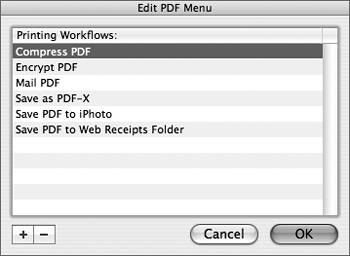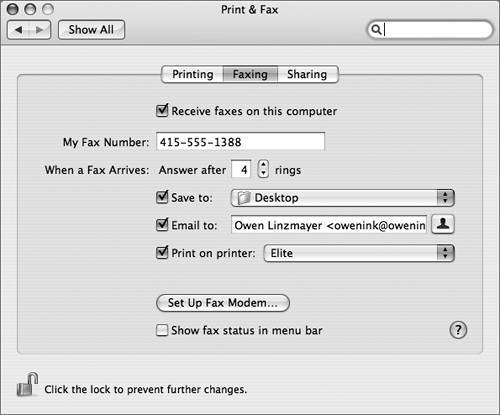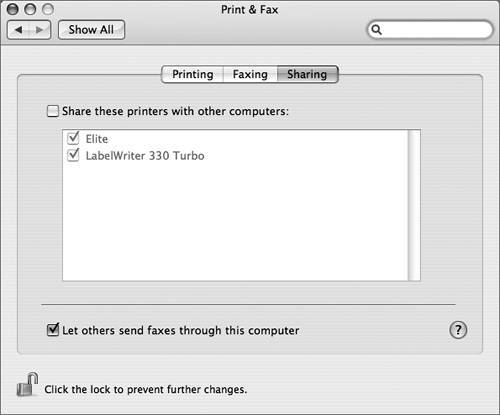Using Other Print Options
Mac OS X has some unique options for outputting
documents that don't involve printing, but they utilize the same
interface because the process is virtually the same as
printing.
Saving Documents as PDF Files
In Mac OS X, it is easy for you to save a
document as a PDF file. All you need to do is choose File >
Print (Command-P), and then in the Print dialog, click the PDF
button. This reveals a menu from which you can choose Save as PDF.
Enter a name and location for the PDF file, then click Save. You
can open a PDF file with Preview (/Applications/Utilities) or any
of Adobe's Acrobat applications on any platform, making PDF the
perfect vehicle for sharing documents when retaining formatting is
important.

NOTE
Mac OS X 10.4 adds the following PDF menu
options: Compress PDF, Encrypt PDF, Mail PDF, Save as PDF-X, Save
PDF to iPhoto, and Save PDF to Web Receipts Folder.
The ability to save any document as a PDF file
is very useful. It can be extended almost infinitely through the
PDF Workflow feature, which enables you to specify how you will
prepare the PDF and what to do with it after creation. A PDF
workflow is any AppleScript script, Automator action, or
application that can open a PDF file. For example, you can create a
script that applies a Quartz filter to a PDF file, or you can
specify that the PDF file be opened by Adobe Acrobat immediately
after it's created.
To use a PDF workflow you have set up, open a
document and choose File > Print. Then choose your workflow from
the PDF pop-up menu. Your document is converted to a PDF file, and
then the PDF file is immediately opened by your workflow.
To add or delete a PDF workflow, choose Edit
Menu from the PDF pop-up menu in the Print dialog. Then you can add
or delete scripts, applications, or actions in the Printing
Workflows list. The Edit PDF Menu window adds a copy of the
workflow to the ~/Library/PDF Services folder, which enables the
workflow for the current user account. If you want to add a
workflow for all user accounts on that computer, you need to create
a PDF Services folder in /Library and manually add items to it.
Workflows can also be located in /Network/Library/PDF Services.

Working with Documents in PostScript
Format
Although Quartz, the imaging model in Mac OS X,
is based on PDF, it includes support for creating, viewing, and
printing PostScript documents.
Creating PostScript Documents
Several Mac OS X applications, such as Adobe
Illustrator and Adobe Photoshop, have the ability to create and
edit PostScript documents. The Mac OS X printing system allows any
Mac OS X application to create a PostScript file as well. In the
Print dialog, choose "Save PDF as PostScript" from the PDF pop-up
menu and the document will be "printed" to a PostScript file.
Viewing PostScript Documents
In addition to creating PostScript documents,
the Mac OS X imaging system also includes a PostScript interpreter
to allow users to view PostScript documents. If you double-click a
PostScript document in the Finder, it will be opened in Preview by
default. You can also use the ColorSync utility to open a
PostScript file and apply Quartz filters such as Sepia Tone or
Lightness Decrease.
Printing PostScript Documents
Once you have a PostScript file on your
computer, you can print it on either a PostScript or a raster
printer by dragging the file's icon to the desktop printer alias.
You can also print a PostScript file from the command line. (You
could open the PostScript file in Preview and print from there, but
Preview would convert the file to PDF for printing, which might
degrade the quality.)
Faxing Documents
With Mac OS X 10.4, you can "print" a document
to a fax machine using your computer's internal modem and any Mac
OS X application that can print to a normal printer.
Sending Faxes
To fax a document, open it with its default
application, then choose File > Print. In the Print dialog,
choose Fax PDF from the PDF pop-up menu and a configuration sheet
appears.

In the To field, enter the phone number of the
receiving fax machine. Alternatively, click the icon to the right
of the To field to choose a recipient from your Address Book. All
other fields in the configuration sheet are optional. When you are
ready to send your document, click Fax. Mac OS X transmits the
document as a fax through the chosen modem, which must be connected
to a working phone line.
Like printing, the application creates a fax job
and adds it to a fax queue. You can view a list of fax jobs to be
sent and jobs that have been sent in Printer Setup Utility. Choose
View > Show Fax List, select the fax modem, and click Show
Info.
Receiving Faxes
You can also set your system to receive faxes by
selecting the appropriate checkbox in the Faxing pane of Print
& Fax preferences. In addition to specifying how many times the
phone should ring before the fax modem answers, you can specify how
the received fax should be handled: save it as a PDF in a folder,
email it, or print it on a specified printer.
TIP
If you don't want to leave your computer on all
the time to receive an occasional fax, you can put it to sleep. But
before doing so, in the Options pane of Energy Saver preferences,
select the "Wake when the modem detects a ring" checkbox.

Fax Sharing
You can also share your fax/modem with other
computers so they can fax through your computer, the same way you
can share a printer. Click Sharing in Print & Fax preferences,
and select the "Let others send faxes through this computer"
checkbox. Your fax/modem will show up under Shared Fax in the Modem
pop-up menu in the Fax PDF sheet.

Note that when you are sharing your fax/modem,
other computers on the network using your machine to send faxes
will spool their print jobs to /var/spool/fax on your computer, at
which point your computer will handle the faxing. It's important
not to shut down your computer or put it to sleep, otherwise
networked users will not be able to use your fax/modem.
Faxing Status
When the "Show fax status in menu bar" checkbox
is selected in the Faxing pane of Print & Fax preferences, a
fax status menu extra is added to the menu bar. The icon displays
status information when your computer sends or receives a fax.
You can also control some fax functions through
the menu extra. For example, you can answer an incoming call and
treat it as a fax by choosing Answer Now from the fax status menu
extra. If you need to hang up on an incoming fax, choose Hang Up
Now.
|